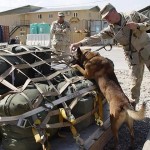Written by Senior Editor Peter Gehr
If you’ve ever had a close encounter with “dog breath” gone wild, it can be very unpleasant. So if you’re looking for the best puppy home remedy for stinky dog breath, then read on.
If this is a continual problem for your pet, then it’s possible you may need to investigate as to the source of the issue. Rather than shy away from the smelly breath, or put up with it thinking it’s normal for your dog, think again, as it may be end result of a health problem that should be attended to immediately.
Best Puppy Home Remedy for Stinky Dog Breath
Dog Bad Breath Causes
All cuteness aside, dog bad breath cannot be ignored. It’s a serious red flag.
It means that something might be terribly wrong with your dog’s health. A smelly dog mouth is a result of a deeper health problem. Generally speaking you have to consider your dog’s oral care status, mainly the health of his teeth and gums. In most cases, a simple oral care routine can easily solve the problem at home.
However, sometimes, the problem can be an internal one, coming from the liver or the digestive system. You’ll have to consult with your Holistic Vet to solve any possibly grave problems and evaluate your dog’s overall health.
Fortunately you can take several key steps to eliminate bad dog breath right at home.
Rosy Gums for Life
Bad dog breath can, generally, be indicative of dental and gum disease – especially in smaller dogs.
Here is a simple and easy way to know if your dog has clear signs of gum disease:
Have some tasty treats ready, invite your dog over and gently open his mouth so that his teeth are visible. What you’re looking for is swollen and discolored gums. Notice any irritation or inflammation along the gum line. If his gums have gone from a baby pink to a fire truck red, gum disease may be the culprit. You need to take immediate action to prevent any further teeth deterioration and health problems.
If you’re not sure about the status of your dog’s oral hygiene, consult your Holistic Vet. Your dog might need a professional oral cleaning and checkup.
Easy Bad Dog Breath Remedies
Bad dog breath is an important health concern that must be taken care of immediately. Don’t just patch it up with a dog breath spray or dog breath mints. Those products are only going to temporarily mask the odor not deal with the initial cause. You want to solve the real problem before it affects your dog’s total wellbeing. Putting on a band-aid just won’t do it.
Natural Dog Bad Breath Home Remedy
Here’s the rule of thumb if you want to insure your dog has a beautiful fresh’n clean mouth:
1. Follow a good healthy diet and include raw meaty bones.
2. Give your pup recreational bones to play and chew on regularly.
3. Regular dog teeth cleaning is a must.
For a quick dog breath freshener I often give our pups some fresh peppermint and/or parsley sprigs. Whichever I have on hand to play and chew on. I do this especially when they’ve just eaten a delicious bowl of smelly sardines. It keeps them busy and it freshens up their breath and their entire digestive system to boot. Truly amazing! (Full story here)
The best puppy home remedy for stinky dog breath is the one that works best for you and your pet, so experiment to see which one does the trick. Teeth are very important to maintain, and starting a cleaning regimen when your puppy is young will assure that his hygiene is kept at a good standard and he will also be used to it as he grows older. For those who simply may not have time to brush your dogs teeth, kibble dog food, chewing bones and keeping your dog away from eating undesirable foods will make a difference.
Comment, Like and Share with your Facebook friends below.










